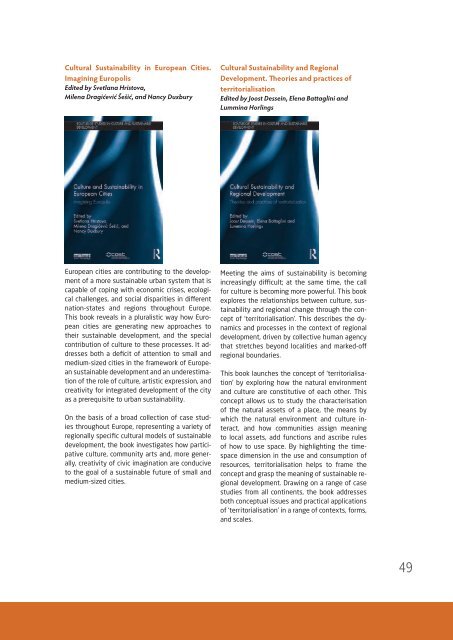Culture in for and as Sustainable Development
YIGflg
YIGflg
You also want an ePaper? Increase the reach of your titles
YUMPU automatically turns print PDFs into web optimized ePapers that Google loves.
Cultural Susta<strong>in</strong>ability <strong>in</strong> European Cities.<br />
Imag<strong>in</strong><strong>in</strong>g Europolis<br />
Edited by Svetlana Hristova,<br />
Milena Dragićević Šešić, <strong>and</strong> Nancy Duxbury<br />
Cultural Susta<strong>in</strong>ability <strong>and</strong> Regional<br />
<strong>Development</strong>. Theories <strong>and</strong> practices of<br />
territorialisation<br />
Edited by Joost Desse<strong>in</strong>, Elena Battagl<strong>in</strong>i <strong>and</strong><br />
Lumm<strong>in</strong>a Horl<strong>in</strong>gs<br />
European cities are contribut<strong>in</strong>g to the development<br />
of a more susta<strong>in</strong>able urban system that is<br />
capable of cop<strong>in</strong>g with economic crises, ecological<br />
challenges, <strong>and</strong> social disparities <strong>in</strong> different<br />
nation-states <strong>and</strong> regions throughout Europe.<br />
This book reveals <strong>in</strong> a pluralistic way how European<br />
cities are generat<strong>in</strong>g new approaches to<br />
their susta<strong>in</strong>able development, <strong>and</strong> the special<br />
contribution of culture to these processes. It addresses<br />
both a deficit of attention to small <strong>and</strong><br />
medium-sized cities <strong>in</strong> the framework of European<br />
susta<strong>in</strong>able development <strong>and</strong> an underestimation<br />
of the role of culture, artistic expression, <strong>and</strong><br />
creativity <strong>for</strong> <strong>in</strong>tegrated development of the city<br />
<strong>as</strong> a prerequisite to urban susta<strong>in</strong>ability.<br />
On the b<strong>as</strong>is of a broad collection of c<strong>as</strong>e studies<br />
throughout Europe, represent<strong>in</strong>g a variety of<br />
regionally specific cultural models of susta<strong>in</strong>able<br />
development, the book <strong>in</strong>vestigates how participative<br />
culture, community arts <strong>and</strong>, more generally,<br />
creativity of civic imag<strong>in</strong>ation are conducive<br />
to the goal of a susta<strong>in</strong>able future of small <strong>and</strong><br />
medium-sized cities.<br />
Meet<strong>in</strong>g the aims of susta<strong>in</strong>ability is becom<strong>in</strong>g<br />
<strong>in</strong>cre<strong>as</strong><strong>in</strong>gly difficult; at the same time, the call<br />
<strong>for</strong> culture is becom<strong>in</strong>g more powerful. This book<br />
explores the relationships between culture, susta<strong>in</strong>ability<br />
<strong>and</strong> regional change through the concept<br />
of ‘territorialisation’. This describes the dynamics<br />
<strong>and</strong> processes <strong>in</strong> the context of regional<br />
development, driven by collective human agency<br />
that stretches beyond localities <strong>and</strong> marked-off<br />
regional boundaries.<br />
This book launches the concept of ‘territorialisation’<br />
by explor<strong>in</strong>g how the natural environment<br />
<strong>and</strong> culture are constitutive of each other. This<br />
concept allows us to study the characterisation<br />
of the natural <strong>as</strong>sets of a place, the means by<br />
which the natural environment <strong>and</strong> culture <strong>in</strong>teract,<br />
<strong>and</strong> how communities <strong>as</strong>sign mean<strong>in</strong>g<br />
to local <strong>as</strong>sets, add functions <strong>and</strong> <strong>as</strong>cribe rules<br />
of how to use space. By highlight<strong>in</strong>g the timespace<br />
dimension <strong>in</strong> the use <strong>and</strong> consumption of<br />
resources, territorialisation helps to frame the<br />
concept <strong>and</strong> gr<strong>as</strong>p the mean<strong>in</strong>g of susta<strong>in</strong>able regional<br />
development. Draw<strong>in</strong>g on a range of c<strong>as</strong>e<br />
studies from all cont<strong>in</strong>ents, the book addresses<br />
both conceptual issues <strong>and</strong> practical applications<br />
of ‘territorialisation’ <strong>in</strong> a range of contexts, <strong>for</strong>ms,<br />
<strong>and</strong> scales.<br />
49




